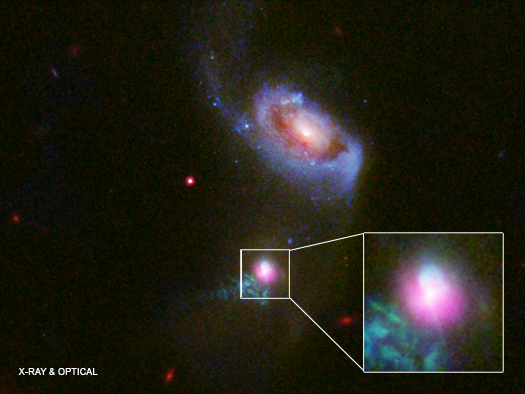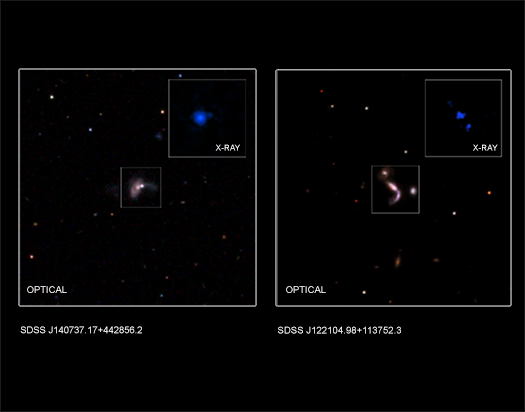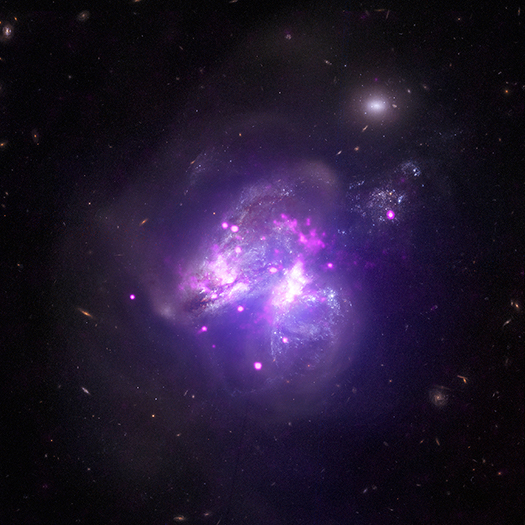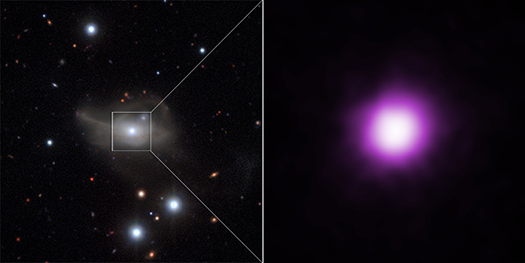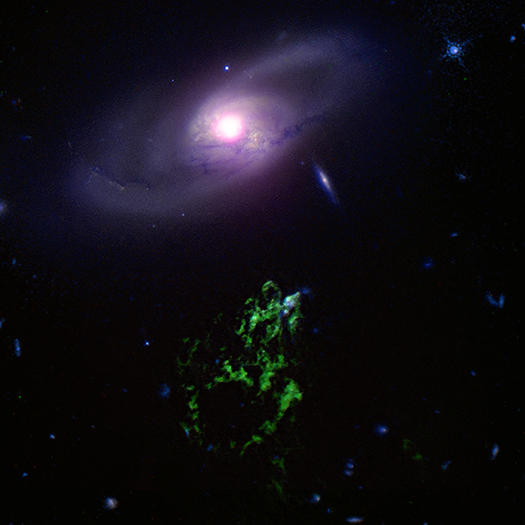Quasars & Active Galaxies
Playing it Safe: Chandra's Return to Science Observations
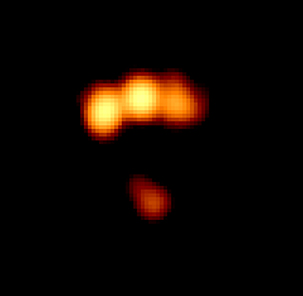
Credit: NASA/CXC/Trinity University/D. Pooley et al.
On October 10th, NASA’s Chandra X-ray Observatory went into “safe mode,” following a glitch on one of the telescope’s gyroscopes. After hard work by the team at the Chandra X-ray Center, the problem was identified and solved, allowed Chandra to resume science observations less than two weeks later on October 21st.
One of the first targets that Chandra looked at after its return to science was PS 0147+4630, a gravitationally-lensed quasar. What is that exactly? A quasar is a supermassive black hole that is rapidly consuming gas from its surroundings. The gas falls into a disk around the black hole where it becomes hot and generates prodigious amounts of radiation. Gravitational lensing is a phenomenon, first predicted by Einstein, where light from a very distant source is bent by a massive intervening object, such as a large galaxy or a galaxy cluster. This creates multiple images of a single, faraway object and amplifies the brightness of the light, acting in some ways as a natural magnifying glass.
Finding the Happy Medium of Black Holes
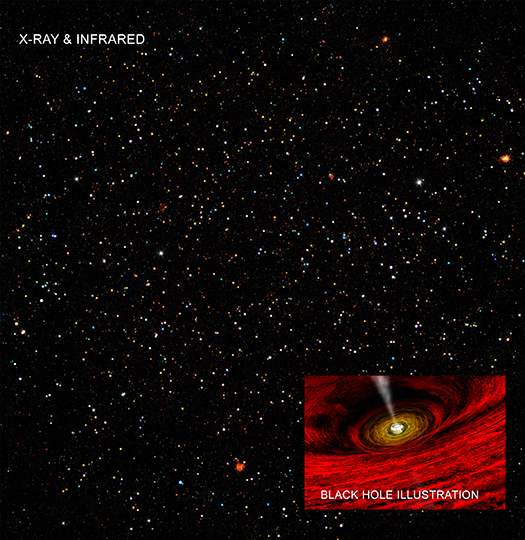
Credit: X-ray: NASA/CXC/ICE/M.Mezcua et al.;
Infrared: NASA/JPL-Caltech; Illustration: NASA/CXC/A.Hobart
This image shows data from a massive observing campaign that includes NASA's Chandra X-ray Observatory. These Chandra data have provided strong evidence for the existence of so-called intermediate-mass black holes (IMBHs). Combined with a separate study also using Chandra data, these results may allow astronomers to better understand how the very largest black holes in the early Universe formed, as described in our latest press release.
The COSMOS ("cosmic evolution survey") Legacy Survey has assembled data from some of the world's most powerful telescopes spanning the electromagnetic spectrum. This image contains Chandra data from this survey, equivalent to about 4.6 million seconds of observing time. The colors in this image represent different levels of X-ray energy detected by Chandra. Here the lowest-energy X-rays are red, the medium band is green, and the highest-energy X-rays observed by Chandra are blue. Most of the colored dots in this image are black holes. Data from the Spitzer Space Telescope are shown in grey. The inset shows an artist's impression of a growing black hole in the center of a galaxy. A disk of material surrounding the black hole and a jet of outflowing material are also depicted.
Researchers Catch Supermassive Black Hole Burping — Twice
Using data from several telescopes including NASA's Chandra X-ray Observatory, astronomers have caught a supermassive black hole snacking on gas and then "burping" — not once but twice, as described in our latest press release.
This graphic shows the galaxy, called SDSS J1354+1327 (J1354 for short) in a composite image with data from Chandra (purple), and the Hubble Space Telescope (HST; red, green and blue). The inset box contains a close-up view of the central region around J1354's supermassive black hole. A companion galaxy to J1354 is shown to the north. Researchers also used data from the W.M. Keck Observatory atop Mauna Kea, Hawaii and the Apache Point Observatory (APO) in New Mexico for this finding.
Chandra detected a bright, point-like source of X-ray emission from J1354, a telltale sign of the presence of a supermassive black hole millions or billions of times more massive than our sun. The X-rays are produced by gas heated to millions of degrees by the enormous gravitational and magnetic forces near the black hole. Some of this gas will fall into the black hole, while a portion will be expelled in a powerful outflow of high-energy particles.
Giant Black Hole Pair Photobombs Andromeda Galaxy

Professor Emily Levesque & Trevor Dorn-Wallenstein
Trevor is a third-year Astronomy graduate student at the University of Washington in Seattle, working with Professor Emily Levesque. He led the paper that is the subject of our latest press release on the discovery of a giant black hole pair that is photobombing the Andromeda Galaxy. He is interested in massive stars and young stellar populations, as well as playing the drums and baking cookies.
It’s funny how a simple case of mistaken identity can lead to the discovery of exotic objects hiding as unassuming dots in the sky.
My advisor, Professor Emily Levesque, and I, both astronomers at the University of Washington, were interested in finding star systems called red supergiant X-ray binaries. These systems consist of a compact object, like a neutron star or black hole, and a red supergiant — massive stars like Betelgeuse that are 10-20 times the mass of our sun but much less hot. Mass from the supergiant is lost to the compact object, where it should heat up and glow brightly in X-rays. While no such systems have been conclusively identified, red supergiant X-ray binaries could be used to better understand the evolution of the most extreme star systems.
Seeing Double: Scientists Find Elusive Giant Black Hole Pairs
This graphic shows two of five new pairs of supermassive black holes recently identified by astronomers using a combination of data from NASA's Chandra X-ray Observatory, the Wide-Field Infrared Sky Explorer Survey (WISE), the ground-based Large Binocular Telescope in Arizona, and the Sloan Digital Sky Survey (SDSS) Mapping Nearby Galaxies at APO (MaNGA) survey. This discovery could help astronomers better understand how giant black holes grow and how they may produce the strongest gravitational wave signals in the Universe, as described in our press release.
Each pair contains two supermassive black holes weighing millions of times the mass of the Sun. These black hole couples formed when two galaxies collided and merged with each other, forcing their supermassive black holes close together. While theoretical models have predicted such giant growing black hole pairings should be relatively abundant, they have been difficult to find.
Arp 299: Galactic Goulash
What would happen if you took two galaxies and mixed them together over millions of years? A new image including data from NASA's X-ray Observatory reveals the cosmic culinary outcome.
Arp 299 is a system located about 140 million light years from Earth. It contains two galaxies that are merging, creating a partially blended mix of stars from each galaxy in the process.
However, this stellar mix is not the only ingredient. New data from Chandra reveals 25 bright X-ray sources sprinkled throughout the Arp 299 concoction. Fourteen of these sources are such strong emitters of X-rays that astronomers categorize them as "ultra-luminous X-ray sources," or ULXs.
These ULXs are found embedded in regions where stars are currently forming at a rapid rate. Most likely, the ULXs are binary systems where a neutron star or black hole is pulling matter away from a companion star that is much more massive than the Sun. These double star systems are called high-mass X-ray binaries.
Stellar Gluttony: Force-feeding a Massive Black Hole for over a Decade

Dr. Dacheng Lin
We are pleased to welcome Dr. Dacheng Lin as our guest blogger. Dacheng is the first author of a new Nature Astronomy paper that is the subject of our latest press release. This paper describes the discovery of a super-long tidal disruption event. Dacheng is a research scientist at the University of New Hampshire. After obtaining his PhD from Massachusetts Institute of Technology, he was a postdoc at IRAP, France and then at the University of Alabama. His main research interests include X-ray binaries, intermediate-mass black holes, and tidal disruption events.
Life is full of surprises and serendipity. My first time hearing about tidal disruption events (TDEs), where tidal forces from black holes rip stars apart, was in a colloquium at MIT when I just became a graduate student. At that time, as a new astronomer, I was hesitant to accept this "crazy" concept.
My involvement with TDE research began when I was a postdoc at IRAP, France. At that time, I took a long, systematic look at thousands of sources detected by a European Space Agency X-ray observatory called XMM-Newton. From that project I learned that most X-ray sources are active galactic nuclei (AGNs), which are supermassive black holes (SMBHs) at the center of galaxies that pull in – that is accrete – surrounding gas and emit copious amounts of radiation, including X-rays. Radiation from AGNs do not vary a lot because the gas surrounding them extends over a large scale and can last for tens of thousands of years.
Starvation Diet for Black Hole Dims Brilliant Galaxy
Astronomers may have solved the mystery of the peculiar volatile behavior of a supermassive black hole at the center of a galaxy. Combined data from NASA's Chandra X-ray Observatory and other observatories suggest that the black hole is no longer being fed enough fuel to make its surroundings shine brightly.
Monster Flares in Otherwise Ordinary Extragalactic X-ray Binaries'

Jimmy Irwin
We are pleased to welcome Jimmy Irwin as our guest blogger today. Jimmy is the first author of a new Nature paper describing the detection of two mysterious, flaring X-ray sources in Chandra data. Irwin is an associate professor at the University of Alabama. After obtaining his PhD from the University of Virginia, he was a postdoc, a Chandra Fellow, and a research scientist at the University of Michigan. He studies the X-ray binary and hot gas content of galaxies, as well as the hot intracluster medium of groups and clusters of galaxies.
Projects don't always turn out the way one expects them to. Sometimes the result is uninteresting, but other times they far exceed expectations. Our project began as an undergraduate endeavor for two students looking to work on a project for college credit. A third student, who was a friend of one of the students, joined the project just for fun.
A Black Hole Story Told by a Cosmic Blob and Bubble
Two cosmic structures show evidence for a remarkable change in behavior of a supermassive black hole in a distant galaxy. Using data from NASA’s Chandra X-ray Observatory and other telescopes, astronomers are piecing together clues from a cosmic “blob” and a gas bubble that could be a new way to probe the past activity of a giant black hole and its effect on its host galaxy.
The Green Blob, a renowned cosmic structure also called “Hanny’s Voorwerp” (which means “Hanny’s object” in Dutch), is located about 680 million light years from Earth. This object was discovered in 2007 by Hanny van Arkel, at the time a school teacher, as part of the citizen science project called Galaxy Zoo.

